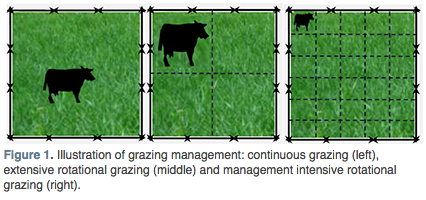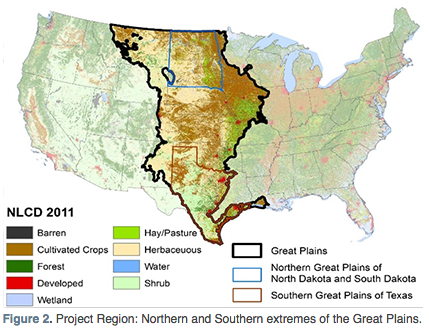By Tong Wang, Extension Advanced Production Specialist
Grasslands in the U.S. are threatened by overgrazing, increasingly frequent and severe drought, and land use change. It is therefore vital for grassland managers to maintain resilient ecosystems while optimizing long-term economic returns. Appropriate grazing management practices enable maintenance of forage productivity, combat invasion by less palatable grasses and weeds, and sustain higher stocking rates, which in turn increases maximum long-term economic profit compared to other agricultural production options.
Continuous Grazing vs. Rotational Grazing
On pasture and rangelands of the Great Plains, continuous grazing is the conventional practice for domesticated livestock production. Under continuous grazing, livestock have unrestricted access to the entire pasture/rangeland throughout the grazing season. Rangeland degradation is common under continuous grazing, due to the regularly used practices such as pesticide usage and supplemental feeding (Müller et al., 2015).
In contrast to continuous grazing, rotational grazing rotates livestock through several paddocks, with only one paddock grazed at a time while other paddocks rest. In practice, rotational grazing management has various levels of intensity (Figure 1).
Under extensive rotational grazing, usually 4 to 8 paddocks are used per herd and livestock graze on each paddock for weeks to months before moving to the next one. As the grazing system becomes more intensive, the grazing area is divided into more paddocks, and the cattle are rotated on a more frequent basis. Management Intensive Grazing (MIG) is an intensive form of rotational grazing, which generally utilizes at least 20 paddocks with very short grazing periods of 1 to 7 days followed by a grass recovery period of 60 to 90 days depending on the weather conditions (Teague et al., 2013)
Intensive Rotational Grazing
 Unlike continuous grazing, intensive rotational grazing usually allows sufficient time for defoliated grass to regrow and hence sustains long-term grassland resilience. Based on a recent article from NRCS1, a well-managed rotational grazing system fared well during drought and provides better drought recovery due to a better mix of grass and more water holding capacity. Anecdotal evidences show intensive rotational grazing practice or MIG helped ranchers extended their grazing season and reduced purchased forage cost.
Unlike continuous grazing, intensive rotational grazing usually allows sufficient time for defoliated grass to regrow and hence sustains long-term grassland resilience. Based on a recent article from NRCS1, a well-managed rotational grazing system fared well during drought and provides better drought recovery due to a better mix of grass and more water holding capacity. Anecdotal evidences show intensive rotational grazing practice or MIG helped ranchers extended their grazing season and reduced purchased forage cost.
Research results also indicates more profitability increased were achieved under MIG compared to extensive rotational grazing (Foltz and Liang, 2005). In addition, extensive rotational grazing practitioners generally showed more interest in increasing the paddock numbers compared to the continuous grazing practitioners (Kim et al., 2008).
Low Adoption Rates of Rotational Grazing Practice
Despite anecdotal evidence and support from consultants and government, adoption of rotational grazing practice remains low. According to the 2012 USDA agricultural census, 288,719 farms practiced some forms of rotational grazing, accounting for less than 30% of all ranching farms in the United States.
Moreover, most farms adopting rotational grazing are under extensive rotational grazing, instead of intensive rotational grazing, MIG. The low uptake likely indicates unfavorable perceptions about MIG among a majority of producers (Roche et al., 2015).
New Multi-Disciplinary Effort
Our recently funded NIFA AFRI project, “Saving Grassland of the Great Plains: Is Management Intensive Grazing (MIG) a Socioeconomically Viable Option?”2, aims to provide a comprehensive analysis of MIG benefits across different regions to determine whether MIG is a win-win solution for both ranchers and society, to better understand factors that affect adoption decisions and the proper incentives government may provide.
This project will cover North Dakota, South Dakota and Texas, which are located on the Northern and Southern extremes of the Great Plains (Figure 2), a region with 19% of the cow inventory and nearly one third of the total grazing land in the nation (NRI, 2012).
 The overall goal of this multi-disciplinary effort is to investigate the economic, environmental and land use consequences of MIG practice in the Northern and Southern Great Plains of U.S., as well as barriers for non-adoption and incentives to overcome such barriers, to help ranchers to increase profit from rangeland and pasture, while decreasing surface runoff and increasing soil infiltration.
The overall goal of this multi-disciplinary effort is to investigate the economic, environmental and land use consequences of MIG practice in the Northern and Southern Great Plains of U.S., as well as barriers for non-adoption and incentives to overcome such barriers, to help ranchers to increase profit from rangeland and pasture, while decreasing surface runoff and increasing soil infiltration.






Post a comment
Report Abusive Comment